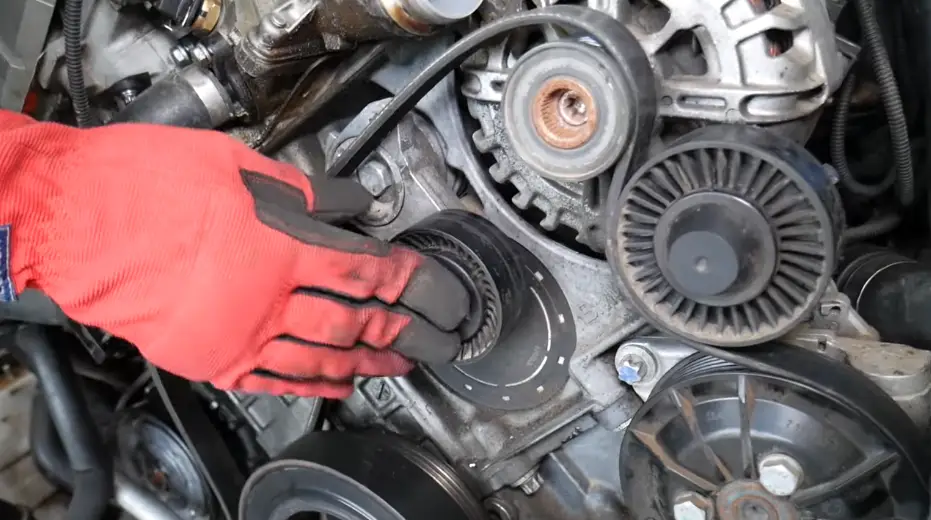A serpentine belt that keeps coming off is often caused by misaligned or damaged pulleys, a failing tensioner, or a worn-out belt. Contamination from oil or coolant leaks can also make the belt slip. To fix the issue, inspect and align pulleys, replace faulty components, and ensure proper belt installation
The serpentine belt, a critical component of the car’s engine, is responsible for powering key systems such as the alternator, power steering pump, water pump, and air conditioning. If your serpentine belt keeps coming off, it’s not just an inconvenience; it can lead to serious engine damage. This blog explores the potential causes, how to fix the issue, and tips to prevent it from happening again.

Contents
Role of the Serpentine Belt
The serpentine belt is a single, continuous belt that winds through various pulleys in the engine. Its design ensures efficiency, but it also means that if the belt slips off or breaks, multiple systems fail simultaneously. Common symptoms of a displaced serpentine belt include:
- Loss of power steering.
- Overheating engine.
- Dim headlights or electrical failures.
- Unusual squealing or slapping noises under the hood.
Recognizing the signs early is crucial to prevent further damage.
Causes of a Serpentine Belt Keeps Coming Off
Common causes of a serpentine belt coming off include:
1. Misaligned or Worn-Out Pulleys
Misaligned pulleys are one of the leading causes of serpentine belt issues. A bent or improperly mounted pulley can cause the belt to slip off. Similarly, pulleys with worn-out bearings or damaged surfaces fail to provide proper traction.
Signs of pulley issues:
- Visible wobbling of the pulley.
- Grinding or squealing noises.
- Belt edges appear frayed.
2. Faulty Belt Tensioner
The belt tensioner maintains the correct tension on the serpentine belt, ensuring it stays in place as it rotates. A weak or failing tensioner can allow the belt to loosen, causing it to slip off.
Indications of a failing tensioner:
- The belt feels loose when inspected.
- Tensioner arm appears stuck or unresponsive.
- Increased belt wear on one side.
3. Incorrect Belt Installation
Improper installation, such as routing the belt incorrectly through the pulleys, can lead to alignment problems. It’s essential to follow the vehicle’s belt routing diagram to avoid this issue.
4. Engine Mount Problems
Worn-out engine mounts can cause the engine to shift slightly, disrupting the alignment of the pulleys and tensioner. This misalignment can force the serpentine belt off its path.
Symptoms of bad engine mounts:
- Excessive engine vibration.
- Clunking noise during acceleration or braking.
- Misaligned pulleys upon inspection.
5. Oil or Coolant Contamination
Fluid leaks from the engine, such as oil or coolant, can degrade the serpentine belt material, making it slippery and prone to slipping off.
Warning signs:
- Visible fluid on the belt or surrounding components.
- Slick or shiny belt surface.
- Presence of leaks under the car.
6. Damaged Belt
If the serpentine belt is old or damaged, it may not stay in place. Cracks, glazing, or fraying indicate the need for replacement.
How to Fix Serpentine Belt Keeps Coming Off Issue
To fix a serpentine belt that keeps coming off:
1. Inspect and Replace the Belt
- Check the belt for signs of wear or damage.
- Replace the serpentine belt with a high-quality replacement, ensuring it matches your vehicle’s specifications.
2. Align the Pulleys
- Inspect all pulleys for proper alignment using a straightedge tool.
- Replace any bent or misaligned pulleys.
- Check for debris or rust that could affect pulley operation.
3. Check the Tensioner
- Test the tensioner by applying pressure to the tensioner arm. It should move smoothly and return to its original position.
- Replace the tensioner if it’s weak, sticking, or damaged.
4. Repair Engine Mounts
- Have a professional mechanic inspect the engine mounts.
- Replace any damaged or worn mounts to restore proper engine alignment.
5. Address Fluid Leaks
- Locate and repair any leaks in the engine.
- Clean the serpentine belt and pulleys to remove contaminants.
6. Proper Installation
- Follow the belt routing diagram provided in your vehicle’s manual or under the hood.
- Ensure the belt is seated properly in all pulley grooves.

Frequently Asked Questions
Here are some FAQs about serpentine belt problem –
1. How do I know if my serpentine belt is misaligned?
Symptoms of misalignment include unusual squealing noises, visible fraying on the belt edges, and wobbling pulleys.
2. Can I drive without a serpentine belt?
Driving without a serpentine belt is not advisable. Critical systems such as power steering, the alternator, and the cooling system will stop working, potentially causing severe engine damage.
3. What is the cost to replace a serpentine belt?
The cost varies depending on the vehicle but typically ranges from $50 to $200, including labor. Replacing additional components like the tensioner or pulleys may increase the cost.
4. How long does a serpentine belt last?
A serpentine belt typically lasts 50,000 to 100,000 miles, depending on the quality of the belt and driving conditions. Regular inspections can help ensure it’s replaced before failure.
5. Why does my serpentine belt squeal when it’s still on?
A squealing serpentine belt may indicate improper tension, a misaligned pulley, or contamination by oil or coolant. Inspect and address the root cause promptly.
Conclusion
A serpentine belt that keeps coming off can be more than just a nuisance—it can jeopardize your vehicle’s performance and safety. Knowing the causes, taking appropriate repair measures, and following preventive maintenance practices can help ensure your belt stays securely in place. If you’re unsure about diagnosing or fixing the issue, consult a professional mechanic to avoid further damage to your vehicle.
By staying proactive, you can keep the engine running smoothly and extend the life of your serpentine belt system.